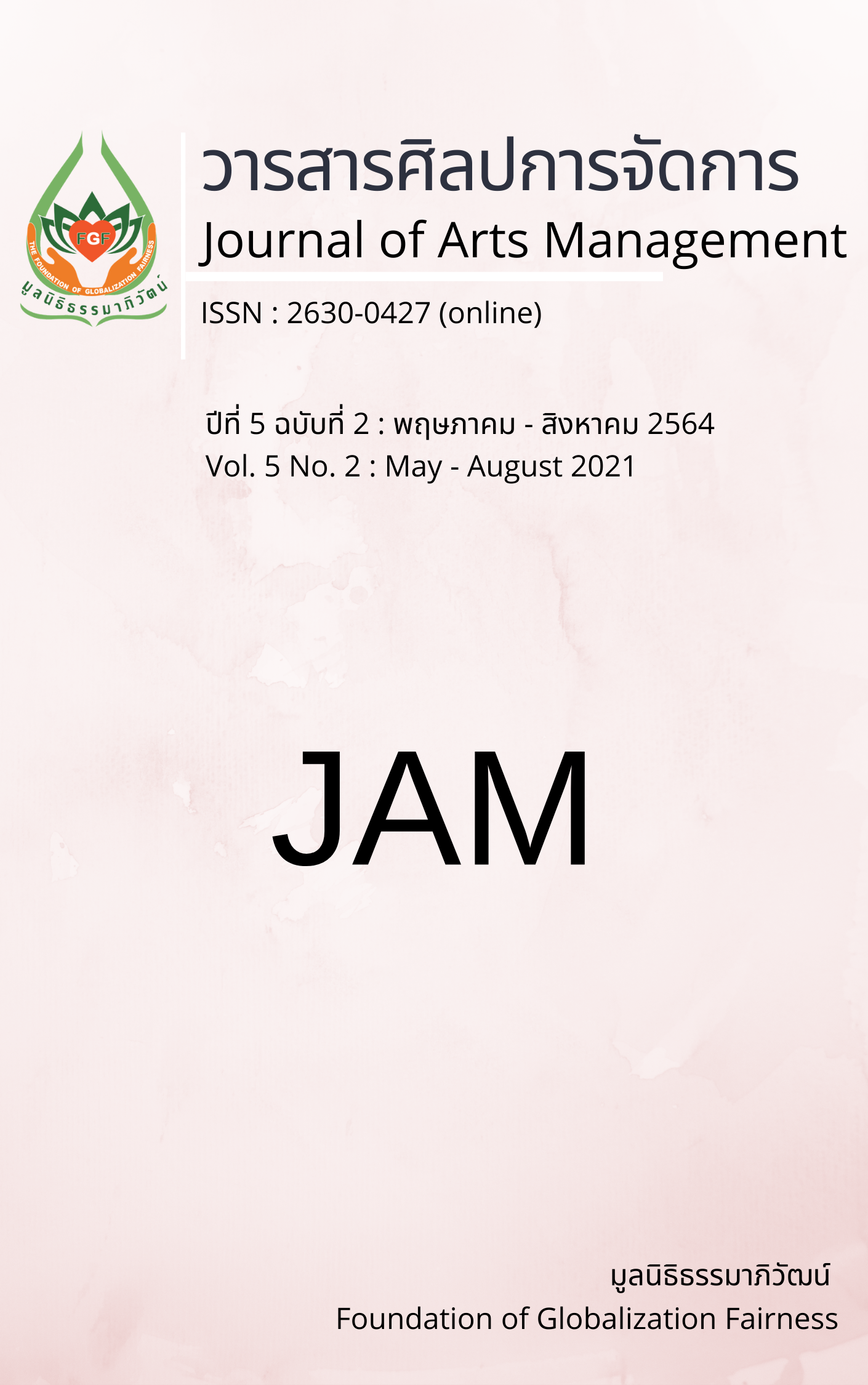Causal Factors Influencing Customer's Brand Value Affecting Performance Gold Jewelry Business Group In Bangkok and its Vicinity
Main Article Content
Abstract
A study of the causal factors influencing customer brand value on results of operations. Gold jewelry business in Bangkok and its vicinity Objective 1) To study the causal factors influencing the customer's brand value on the results of operations. Gold jewelry business group In Bangkok and its vicinity (2) To study the brand value of customers that affect the market performance of the gold jewelry business group. In Bangkok and its vicinity, this research is a mixed research (Mixed Methods). It is a quantitative research. And qualitative the researcher determined the population for this study was the consumers who traded gold in gold shops. In Bangkok and metropolitan area, number 37 places, sample group 400 people the researcher used the Accidental Sampling method. The researcher analyzed the data using questionnaires and interviewed data. By means of Purposive Interview from 14 interviewees, the researcher analyzed the data by constructing a Structural Equation Modeling (SEM), a statistical technique used in the causal relationship testing. (Causal Relationships) and confirm the results from empirical data.
The results showed that the model was harmonized with the empirical data, with the six indexes that met the acceptance criteria: index 2/df = 1, CFI = 1.00, GFI = 0.96, AGFI = 0.951., RMSEA = 0.030 and SRMR = 0.019. So it can be concluded that The structural equation modeling model is suitable. Harmonize with empirical data and from the results of the path analysis, it was found that Customer relationship management Customer brand value Service marketing mix the perception of service quality has a positive direct influence on marketing performance. It was statistically significant at level 0.01 and from interviews, it was concluded that the model could be used for further use in gold jewelry business administration.
Article Details
Views and opinions appearing in articles in the Journal of Arts of Management It is the responsibility of the author of the article. and does not constitute the view and responsibility of the editorial team I agree that the article is copyright of the Arts and Management Journal.
References
ซ่อนกลิ่น สมอ. (2551). ปัจจัยที่มีอิทธิพลต่อการตัดสินใจซื้อทองรูปพรรณของลูกค้า กรณีศึกษาจังหวัดภูเก็ต(วิทยานิพนธ์บริหารธุรกิจมหาบัณฑิต). มหาวิทยาลัยราชภัฏภูเก็ต.
ศิริกานดา แหยมคง. (2555). ปัจจัยเหตุและผลของความสามารถการจัดการลูกค้าเชิงสัมพันธภาพของธุรกิจโรงแรมในประเทศไทย(วิทยานิพนธ์การจัดการดุษฎีบัณฑิต). มหาวิทยาลัยศรีปทุม.
สิทธิพัฒน์ พิพิธกุล. (2560). ปัจจัยที่มีอิทธิพลต่อพฤติกรรม และแนวโน้มการลงทุนในทองคำแท่งของนักลงทุนในเขตกรุงเทพมหานคร(วิทยานิพนธ์ปริญญาบริหารธุรกิจมหาบัณฑิต). มหาวิทยาลัยสยาม.
Aaker, D. A. (1996). Measuring Brand Equity Across Products and Markets. California Management Review, 38(3), 102-120.
Akroush, M. N., Dahiyat, S. E., Gharaibeh, H. S., & Abu-Lail, B. N (2011). Customer Relationship Management Implementation: An Investigation of a Scale’s Generalizability and its Relationship with Business Performance in a Developing Country Context. International Journal of Commerce and Management, 21(2), 158-191.
Chen, Hui-Chu. (2007). Customers' Perceptions of the Marketing Mix and the Effect on Taiwan Hypermarkets' Brand Equity(Doctor of Philosophy). Lynn University.
Day, G. S., & Van den Bulte, C. (2002). Superiority in Customer Relationship Management: Consequences for Competitive Advantage and Performance. The Wharton School, University of Pennsylvania.
Dmour, H. et al. (2013). The Effect of Services Marketing Mix Elements on Customer-Based Brand Equity: An Empirical Study on Mobile Telecom Service Recipients in Jordan. International Journal of Business and Management, 8(11), 13-26.
Keller, K. L. (1993). Conceptualizing, Measuring, and Managing Customer-Based Brand Equity. Journal of Marketing, 57(1), 1-22.
Kumar, M., Kee, F. T., & Charles, V. (2010). Comparative Evaluation of Critical Factors in Delivering Service Quality of Banks: An Application of Dominance Analysis in Modified SERVQUAL Model. International Journal of Quality & Reliability Management, 27(3), 352-378.
Majeed, S. (2011). The Impact of Competitive Advantage on Organizational Performance. European Journal of Business and Management, 3(4), 191–196.
Mishra, P. et al. (2011). Perpetual Asset Management of Customer-Based Brand Equity The PAM Evaluator. Current Research Journal of Social Sciences, 3(1). 34-43.
Pike, S., Bianchi, C., Kerr, G., & Patti, C. (2010). Consumer-Based Brand Equity for Australia as a Long‐haul Tourism Destination in an Emerging Market. International Marketing Review, 27(4), 434-449.
Pinar, M., Girard, T., & Eser, Z. (2012). Consumer-Based Brand Equity in Banking Industry: A Comparison of Local and Global Banks in Turkey. International Journal of Bank Marketing, 30(5), 359-375.
Sreenivasan, J., & Bains, S. (2011). Customer Satisfaction of Quality in a Malaysian Mobile Phone Manufacturing Company: An Employees’ Perception. Journal of Applied Sciences, 11(22), 3688-3697.
Sultan, P., & Yin Wong, H. (2013). Antecedents and Consequences of Service Quality in a Higher Education Context: A Qualitative Research Approach. Quality Assurance in Education, 21(1). 70-95.
Veloutsou, C., Christodoulides, G., & de Chernatony, L. (2013). A taxonomy of measures for consumer‐based brand equity: drawing on the views of managers in Europe. Journal of Product & Brand Management, 22(3), 238-248.


